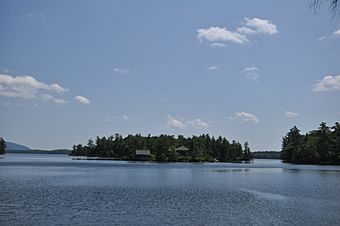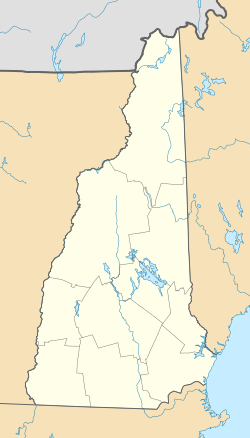Camp Carnes facts for kids
Quick facts for kids |
|
|
Camp Carnes
|
|
 |
|
| Location | On an island in Carnes Cove, Squam Lake, Holderness, New Hampshire |
|---|---|
| Built | 1894 |
| NRHP reference No. | 12000506 |
| Added to NRHP | August 15, 2012 |
Camp Carnes is a special historic summer camp located in Holderness, New Hampshire. It sits on a small island in Carnes Cove, which is part of Squam Lake. This camp was built way back in 1894, making it one of the very first camps to be set up on an island in Squam Lake.
Camp Carnes is also connected to the important Webster family, who owned a lot of land in the area. Because of its history, Camp Carnes was added to the National Register of Historic Places in 2012. This means it's recognized as an important historical site.
Discovering Camp Carnes' Location and History
Where is Camp Carnes?
Carnes Cove is a part of Squam Lake that reaches north into the town of Holderness. Carnes Island is one of the smaller islands inside this cove. It's located between a larger island called Groton Island and the mainland to the north.
How Camp Carnes Began
For a long time, the area around Squam Lake was mostly used for farming. But in the late 1800s, people started to see it as a great place for summer vacations.
Frank and Mary Webster were a couple who enjoyed spending their summers at a hotel called Asquam House in Holderness. Frank Webster was a partner in a big company in New York City called Kidder, Peabody & Co.. In 1894, they decided to buy Carnes Island and Groton Island.
The very first known island camp on Squam Lake was built by the Cook family on Kent Island in 1886. Before the Websters bought Carnes Island, there was a small fishing hut there used by William Carnes. The Websters replaced this hut with a much nicer building for their camp.
Even though summer camps are often thought of as "rustic" or simple, the Websters liked to be comfortable. They brought maids with them every summer! They even served their meals on fancy linen tablecloths and china plates that had "Camp Carnes" written on them. Later, the Websters bought even more land nearby and built the large Webster Estate.



